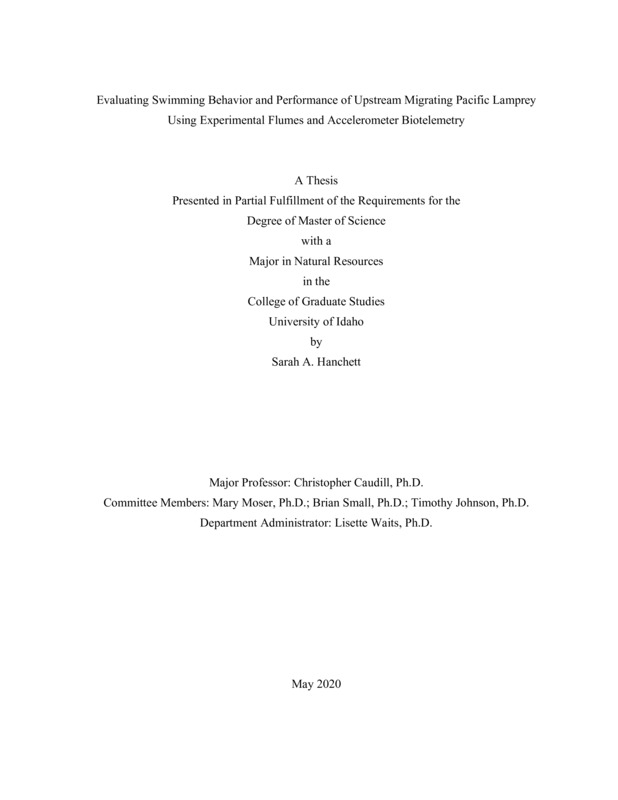Evaluating swimming behavior and performance of upstream migrating Pacific lamprey using experimental flumes and accelerometer biotelemetry
Hanchett, Sarah Ann. (2020-05). Evaluating swimming behavior and performance of upstream migrating Pacific lamprey using experimental flumes and accelerometer biotelemetry. Theses and Dissertations Collection, University of Idaho Library Digital Collections. https://www.lib.uidaho.edu/digital/etd/items/hanchett_idaho_0089n_11769.html
- Title:
- Evaluating swimming behavior and performance of upstream migrating Pacific lamprey using experimental flumes and accelerometer biotelemetry
- Author:
- Hanchett, Sarah Ann
- ORCID:
- 0000-0002-4265-792X
- Date:
- 2020-05
- Keywords:
- Fish
- Program:
- Natural Resources
- Subject Category:
- Wildlife management
- Abstract:
-
Stream connectivity is necessary for the persistence and viability of migratory fish populations. However, many of the world’s river contain dams, creating barriers or obstacles that can impede movement. Fishways have been constructed to provide passage for migratory fishes, but traditional designs were largely incorporated for fish with strong burst swimming capabilities, such as subcarangiform swimming salmonids, and do not consider species with alternate swimming modes (i.e anguilliform). Additionally, high velocities and turbulent conditions within fishways can force fish to swim at prolonged swimming speeds, potentially resulting in fatigue or delayed passage. The Federal Columbia River Power System (FCRPS) has served as a model system for fish passage designs worldwide. In particular, Bonneville dam, the lowermost dam on the Columbia River, is a complex comprised of three channels separated by islands and has two primary fishways. Each fishway begins with low gradient collection sections that lead to steeper pool and weir ladders, and then transition to vertical slot weirs before exiting into the forebay. It provides passage for a multitude of species, though passage rates are low for several species including Pacific lamprey (Entosphenus tridentatus; ~50% passage rate). Previous research has revealed approximately one quarter to one third of lampreys that reach the serpentine weir section of both fishways fail to pass the dam. Past studies have demonstrated that lamprey can pass single, high velocity vertical slot weir. We hypothesized fatigue may occur during passage of the 12 weirs present in the serpentine weir section and tested this hypothesis using experimental behavioral observations and a novel application of acceleration biotelemetry in at-liberty animals. We manipulated exercise histories of adult Pacific lamprey prior to a weir passage challenge in an experimental flume (11.6-m long × 1.2-m wide × 2.4-m high). Treatments were applied using a 2 × 2 factorial design with two exercise velocities (1.0 m/s and 1.4 m/s) and two exercise durations (1 x 20 min and 2 x 20 min with a 10 min recovery interval) in addition to an unexercised control prior to a high velocity passage challenge at a single vertical slot weir. The results indicate that the exercise history of lamprey and encountered water velocity affect passage success. In the experimental flume experiment, lamprey passage success was lowest (53%) during the high-velocity, long-duration treatment as compared to the control (89%) (2 = 22.3, P < 0.001). Dorsal distance, after accounting for body length, was the only morphological covariate associated with passage success; dorsal distance increased the odds of successful passage. We used accelerometer biotelemetry to identify activity and behavioral responses of adult Pacific lamprey to local passage conditions at a previously identified passage bottleneck (the upper Washington-shore fishway of Bonneville Dam), with an emphasis on the serpentine weir section. Accelerometer biotelemetry results revealed that lamprey exhibited high intraspecific variability in duration and timing of attached and burst movements among sections of the fishway. Within the serpentine weirs, lamprey that were successful at passing spent more time bursting compared to lamprey that did not pass. Unsuccessful fish spent a longer duration attached and had higher turn-around rates, leading to longer residence times when attempting to pass. There was not clear evidence of gradual fatigue associated with non-passage, suggesting threshold changes in behavior or motivation. Collectively, these results reveal that cumulative effects of passage are important to consider when designing or evaluating fishways. Velocities that require high activity levels over a prolonged period of time may induce fatigue, indicating the need for refuge areas to allow recovery.
- Description:
- masters, M.S., Natural Resources -- University of Idaho - College of Graduate Studies, 2020-05
- Major Professor:
- Caudill, Chris C
- Committee:
- Moser, Mary ; Johnson, Timothy ; Small, Brian
- Defense Date:
- 2020-05
- Identifier:
- Hanchett_idaho_0089N_11769
- Type:
- Text
- Format Original:
- Format:
- application/pdf
- Rights:
- In Copyright - Educational Use Permitted. For more information, please contact University of Idaho Library Special Collections and Archives Department at libspec@uidaho.edu.
- Standardized Rights:
- http://rightsstatements.org/vocab/InC-EDU/1.0/

